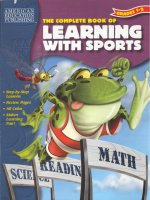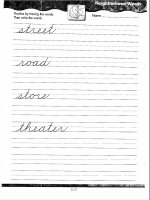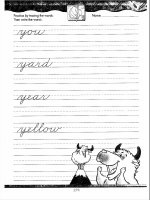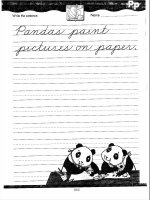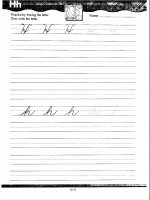Usborne the complete book of human body
Bạn đang xem bản rút gọn của tài liệu. Xem và tải ngay bản đầy đủ của tài liệu tại đây (27.08 MB, 119 trang )
W
USBORNE
THEUSBORNE
COMPLETE BOOK OF THE
Internet
linked
lHl .:IO )lOOH lll1dWO~
3:N'HOHSn 3:H!
Using Internet links
his book contains descriptions
of websites where you can find
out more about the human body.
To visit them, go to the Usborne
Quicklinks Website at
www.usborne-quicklinks.com and
enter the keywords "complete body."
T
Site availability
The links in Usborne Quicklinks are regularly
updated, but sites may sometimes be
temporarily unavailable. If a website closes
down completely, we will, if possible,
replace it with an alternative. You will find
an up-to-date list of sites on the Usborne
Quicklinks Website.
What you need
Most of the websites listed in this book can
be accessed using a standard home
computer and a browser (the software that
lets you look at information on the
Internet). Some sites need extra programs,
known as plug-ins, to play sound or show
videos. If you go to a site and do not have
the right plug-in, a message will come up
on the screen . There is usually a button on
the site that you can click on to download
the plug-in. Alternatively, go
to Usborne Quickl inks
and click on Net Help
to find links to
download plug-ins.
Downloadable pictures
Some of the pictures in this book can be
downloaded from the Usborne Quicklinks
Website and printed out for your own
personal use - for example, as illustrations
for homework. They must not, however, be
copied or distributed for any commercial
purpose. Downloadable pictures have a
symbol beside them. To print out or copy
these pictures, follow the instructions at
www.usborne-quicklinks.com
*
Internet safety
When using the Internet, please follow the
safety guidelines displayed on the Usborne
Quicklinks Website at www.usborne
quicklinks.com . The websites described in
this book and listed in Usborne Quicklinks
are regularly reviewed, but Usborne
Publishing is not responsible for the
availability or content of any website other
than its own .
Microscope and X-ray pictures
Th is microscope picture
shows a tiny embryo made
up of just a few cells on t he
point of a needl e. Over nine
months, it will grow into a fully
formed human being.
Many of the microscope and X-ray images
in this book, such as the one on the left,
have had extra color added to them to
make them clearer. They do not always
show the real colors of the human body.
Contents
6
8
10
12
14
Body Building Blocks
Your amazing body
Body systems
Cells
Genes and DNA
65
66
68
70
72
Eating and Drinking
Taking in food
In your stomach
In the intestines
Waste
16
18
20
22
24
26
28
Muscles and Bones
The skeleton
Join ts
Muscles and tendons
How muscles work
Moving without thinking
Reflexes
74
76
78
80
82
84
86
Health and Medicine
Health and sickness
Diseases
The immune system
Drugs and treatments
Operations
Complementary medicine:
29
30
32
34
Skin, Hair and Nails
What is skin?
Skin changes
Hair and nails
87
88
90
92
94
Body Changes
Conception and birth
Growing up
Hormones
Getting old
.,,16o/;'l·UU~jjiB, rain and the Senses
38· YOl:J
r amazing bra in
"""iO;
40 How the brain works
42 Seeing
44 Hearing
46 Tasting and smelling
48:'' ' Sensation and pain
50 Thinking
52 Fool your brain
53 Breathing and Circulation
Breathing equipment
6 Inside your lungs
58 The heart
60 Circulation
In the blood
'64 The lymphatic system
96
98
100
101
102
104
Facts and Figures
Facts, figures and records
Timeline
Who's who
Experiments and activities
Glossary
108 Index
112 Acknowledgements
The X-rayon this page shows
the ribs, backbone and
collarbone inside a human torso.
Body
Building Blocks
The human body is amazingly complicated.
It's made up of hundreds of different organs,
tubes, tendons, tissues and other body parts,
each with its own job to do. In turn, these
parts are made up of millions of microscopic
units called cells. Inside cells are the smallest
body parts of all - the genes that make us
human. They tell cells how to do all the
things they need to do to make our bodies
work and keep us alive.
Almost every cell in your body contains a set of chromosomes,
where your genes are stored. In the set shown on the opposite
page, the last pair of chromosomes match, showing that they
came from a female . In a male, the last pair .of chromosomes
do not match, and the pair is called XY instead of XX.
Your amazing body
he human body is an amazing machine. Even
though you rarely think about it, your body
is always busy. You have dozens of different
organs, masses of muscles and bones, miles
of blood vessels, millions of cells, and a
brain more powerful than any computer,
all working together to keep you alive.
T
Body parts
Your body is made up of
many different parts and
substances. Here are the
main ones :
• Organs are body parts that
do a particular job for the rest
of your body. For example,
your brain controls your
body, and your lungs collect
the oxygen your body needs.
• Body tissues
include fat,
bone and
muscle.
• Body fluids. Your
body contains many
different fluids (liquids).
Blood is the most important
one. The others include tears,
sweat, and stomach juices.
Red blood celis, an important part of blood,
shown at about 3, 000 times life-size.
• Water makes up 70% of
your body. It's found in your
blood, and in and around the
cells that make up your body.
Your brain, eyes and skin
are ali exampl es of
org ans. Skin is the
biggest org an of all. It
covers and protects
your wh ole body.
GOING WRONG :
Body breakdowns
Although your body is
amazing, it can go wrong .
Look out for these Going
Wrong boxes throughout
the book. They explain all
kinds of body breakdowns
and problems, like what
causes a heart attack, why
teenagers get zits, and
what makes you vomit.
The body parts in this
picture have been
colored so you can tell
them apart. In real life,
most body parts are
pink or reddish-purple.
Eye
a
Nose
,;
Skin
Nerves carry messages
between the brain
and the body.
The spine is a column of bones in
the back. These bones form the
central part of the skeleton and
protect the spinal cord, which hangs
down from the brain and carries
information to and from the body.
Humerus (upper arm bone)
Joint - a link between
bones that allows them
to move and flex .
• •r :'.
*
Small intestine
The kidneys are in the middle
of the back. They filter waste
chemicals from your blood
and control the amount of
water in the body.
Blood vessels
Large intestine
Radius (forearm bone)
Ulna (forearm bone)
Carpals (wrist bones)
..... ,t
Metacarpals (hand bones)
.<..... -.• - -
Artery (carries blood
away from the heart)
Vein (carries blood
back to the heart)
Phalanges (finger bones)
• ~,.
;.
Muscle
Look inside
This picture shows how body parts
are arranged inside your body.
Most of your organs are neatly
packed together inside the chest
and the abdomen (the part of the
body between the chest and the
legs). The head also has a few
organs, including the brain, eyes
and ears. The biggest organ, your
skin, covers your whole body.
The rest of your body, including arms
and legs, is made up of body tissues
including bones, muscles and fat.
r!
Tendon - a type of tough,
stringy body tissue that
connects muscles to bones.
-+----,- - - Tibia (lower leg bone)
Fibula (lower leg bone)
INTERNET LINK
For a link to a website where you
can see amazing scans of the inside
L.
of the human body, go to
www.usborne-quicklinks.com ~
9
Body systems
Skeletal system
ost of your body parts ,work together in
groups called body systems. For example,
your digestive system is a set of organs, tubes and
body tissues that helps you eat and digest food.
You have ten main body systems altogether.
M
Ribs
-----fj~
-----J~
Spine
Pelvis -
Femur
Tangled together
Your body systems are all
intertwined with each other. For
example, th~,«circulatory system
"'if
"
0reach~8%intf!. ,~
Some body parts belong to
more than one system. Your
~hroat, for example, is part of
;~;lgih~r bodX/>;i;.lY9,,§~1g~,§Si. ~~ sxs,~ em and
h
--111--+
- ---HI.
This system
includes the
bones that give
your body its
shape, and the
joints that link
them together.
;'
systems totiike . ood to them. ' ' w pan:''o f'y our respiratory system,
Nervous system
1t;;:~r.:::::;;;~.._~because you use it for
,."
*
both swallowing
"and breathing.
ri' .·-, :'!I.--
Spinal cord
Nerves -
I'
Brain
---1
Your nervous
system includes
your brain and
spinal cord, and
the network of
nerves that links
them to the '
rest of your body.
Nerves
*
Endocrine system
The blood
vessels of your
circulatory system
reach all around
your body. In th is
X-ray you can see
the blood vessels that
supply blood to the
brain, which is part of
your nervous system .
Pituitary
gland
See the systems
INTERNET LINK
For a link to a website where you can
find facts, images and a quiz about
the main body systems, go to ....
www.usborne-quicklinks.com ~
10
These pictures show your
main body systems, each in a
separate diagram. In real life,
they are all tightly packed
together inside your body.
The glands
of your
endocrine
system make
hormones
chemicals that
control the way
your body works,
grows and
changes.
This picture
shows the main
glands in a male.
----li-"ll
*
Skin, hair and nails
Muscular system
Digestive system
Hair on head -
't"...htl
Biceps
muscle
in arm - ---+
Fine hair all
over body
-------=
Liver
fH L
Abdominal
(stomach)
muscles
Mouth
Esophagus
Stomach
'",
~
Intestines
Fingernails - -'
The digestive
system breaks
down food and
extracts useful
chemicals
from it. The
leftovers
leave your
body as waste.
Your muscles
hold you up
and make
your body
parts move.
This body system
protects you from
dirt and danger,
and helps to
control your
temperature.
Respiratory system
Circulatory system
-
~
Mouth
Heart pumps
blood around
the body.
Trachea
*
Urinary system
Lymph
nodes
This huge body
system carries
blood all around
your body. The
blood delivers
oxygen, food and
Qther chemicals to
all your cells.
Your immune
system and
lymphatic system
are connected to
your circulatory
system . They include
white blood cells and
lymph nodes, which kill
germs and fight diseases.
*
Reproductive system
Men and women
have different
reproductive
systems.
IJ!I E
Kidneys
Veins (blood
vessels carrying
blood toward
the heart)
Arteries (blood
vessels carrying
blood away
from the heart)
This system
takes air into your
body and extracts
useful oxygen from
it. It also takes
waste gases out of
your blood so that
you can breathe
them out.
*
This is a common
type of white
blood cell called
a lymphocyte.
A woman's ovaries
make egg cells.
Her womb is
designed to hold
a growing baby,
which is born
through a passage
called her vagina.
Womb
Bladder
•
Your kidneys
filter waste water and
poisonous chemicals
out of your blood .
The waste is stored
in your bladder
and comes out
of your body
as urine.
*
A man's testes
make sperm
cells. They
leave the man's
body through
his penis. They
can swim into
a woman's
body through
her vagina .
Ovary
Vagina
Penis
*
People reproduce
(make babies) by
joining a woman's
egg cell and a
man's sperm cell
together.
11
Cells
Y
our body is made up of cells. Whenever you
look at your hand or at a drop of blood,
you're looking at millions of cells packed tightly
together. But on their own, most cells are too
tiny to see. In all, you have 50 trillion to 100
trillion cells in your body.
INTERNET LINK
This is a diatom, a tiny single-celled plant,
shown 300 times bigger than in real life.
Many living things have only one cell.
For a link to a website where you
can find out a lot more about
L..
different types of cells, go to
www.usborne-quicklinks.com ./JSt'C'
What is a cell?
Making proteins
A cell is a tiny living unit with
its own protective "skin."
Inside, a cell has several parts,
called organelles, which help
it to work. The cells that
make up your body are
working all the time to keep
you alive. They make body
chemicals, carry messages,
and help you to think,
move, eat and breathe.
Your cells make chemicals
called proteins, which help to
make new cells or are used to
do different jobs around your
body. Proteins are made up of
simpler chemicals called
amino acids. By combining
amino acids in different ways,
your cells can make
thousands of
different kinds
of proteins.
This is a microscope photo
of human fat. You can see
how it is made up of
clusters of round fat cell .
Kinds of c ells
The human body has over
200 kinds of cells, including
muscle cells, blood cells,
nerve cells, liver cells, fat cells
and skin cells. Different kinds
of cells do different jobs. Here
are some of them:
*
Red blood cells are
shaped like flattened
balls . They carry oxygen
around your body.
Muscle cells are
long and thin. They
can shorten themselves
to make muscles work.
...-- Nerve cells carry messages
around your brain and
to and from other
parts of your body.
Women's egg cells are some
of the biggest human cells.
They are just big enough
to see with the naked eye.
Inside a cell
Although body cells can look
very different from each other,
most of them have the same
parts. The skin around a cell is
called the cell membrane.
Each cell also has a control
unit called a nucleus. The
cell's other parts, or
organelles, float around in a
watery jelly called cytoplasm.
The cell is full of runny
cytoplasm. It is mostly
made of water, with
thin strands of protein
running through it.
The nucleus controls
everything that happens
in the cell, using
chemical signals. It also
contains the instructions
for making new cells.
The Goigi complex stores
proteins made by the
ribosomes. It may also prepare
the proteins for different uses.
Some cells have finger-like
shapes called cilia on the
outside. They help the cell
to move things like food
particles toward it.
The cytoskeleton
is made of tiny
tubes and threads
that help to give
the cell
its shape.
This picture shows a typical cell,
cut open to reveal its main parts.
Ribosomes are
organelles that
make new
proteins.
This is the
endoplasmic
reticulum .
It transports
proteins
made by the
ribosomes to
other parts
of the cell .
*
Lysosomes destroy old,
damaged organelles and
any dangerous substances
which get into the cell.
Inside the nucleus
The cell nucleus controls what
happens inside the cell,
including the jobs the cell
does and the proteins it
makes. The nucleus can do
this because it contains
complicated instructions
called genes, which are made
of long strands of a chemical
called DNA. You can find out
more about genes and DNA
on the next page.
The mitochondria turn food particles and oxygen
into energy, so that the cell can keep working .
Making new cells
Every second, millions of cells
in your body die, and new ones
have to be made. Most cells
make new cells by dividing into
two. But some kinds of celis,
such as heart muscle celis, do
not keep dying and being
replaced. You keep the same
ones for your whole life.
*
The cell membrane
protects the cell and
holds it together. It also controls
the way substances such as food
particles and water pass into and
out of the cell.
These pictures show
how a cell divides.
First, the cell grows to
twice its original size.
The nucleus makes a
copy of its DNA and
splits into two nuclei.
The enlarged double
cell begins to split in
two down the middle.
Finally, the two new
cells separate from
each other.
13
Genes and DNA
he way your body grows, the way it
works, and what you look like are
all decided by what your cells do. But
how do cells know what to do? The
answer is genes. They are the
instructions inside a cell nucleus
that tell the cell how to work.
T
-=r- - C e l l
T -- -
-:--7--
Cell wall
"'-"- Cytoplasm
--T--~=-----
Cell
What are genes?
Genes are instructions made of
strings of chemicals. They tell
your cells how to build your body
O'1.irn~l<-€ .the substances
and bQw¢t.
71'3$1'$#8"
they neea.'ftiiSmeans genes
control the way your body grows
and the way it works from day to
day. Everyone has a complete set
of human genes, with slight
differences that make each
person unique. Most of the cells
in your body contain a copy of
your complete set of genes.
In real life,
chromosomes are
found inside the cell
nucleus. In this diagram,
a chromosome has been
enlarged and its DNA has
been unwound, so that you
can see how it works.
A gene is a section
of a chromosome.
There are many
: - - - - genes on each
chromosome.
Chromosomes
are made of a
chemical called DNA.
What is DNA?
DNA is the substance
that genes are made of.
The letters DNA are
short for a chemical
called deoxyribonucleic
acid. It has a long, thin
shape like a twisted
ladder. Each cell
contains 46 long strands
of DNA (23 pairs). Each
of these strands is called a
chromosome. A gene is a
section of DNA that makes
up part of a chromosome.
Each chromosome has many
different genes along it.
14
Chromosomes (strands
of DNA) are stored
inside the cell nucleus.
'...i---T-
DNA is made up
of four chemicals
known as bases,
arranged in a
spiral ladder
shape.
In a gene, the pattern
of the fou r bases acts as
a code for a particular
body substance.
*
DNA contains four different
chemicals, called bases. In a
gene, the bases are arranged
in a sequence that acts as a
code for a particular body
protein (a type of body
substance). When a cell needs
to make a protein - such as
keratin, which is used to
make hair - it finds the right
gene and reads the code.
Then it fits chemicals together
in the right order. The
chemicals it uses come from
food, and are delivered to
your cells in your blood.
DNA fingerprinting
This is a printout of the pattern of bases in
a sample of human DNA. Scientists use
powerful computers to read DNA patterns.
Passing on genes
The genes inside your cells are
unique to you (unless you're
an identical twin, as identical
twins have the same genes).
Your own special set of
genes is made of a
mixture of half your
mother's genes,
and half your
father's genes.
They came from
the cells in your
parents' bodies
that were used
to make you.
This is why
people often
look similar
to their
parents.
In this family,
you can see that
both the children look
a little like their mother. Each
of them has inherited a copy
of half of the genes inside her
cells, and half of the genes
inside their dad's cells.
Because most people have
their own, unique DNA
patterns, DNA testing (also
called DNA fingerprinting)
can be used to identify
people. For example, the
DNA patterns in blood cells
left at a crime scene will only
match the DNA of someone
who was there. This helps
police scientists, called
forensic scientists, to identify
crime suspects.
Th is monkey is a type of
early clone. She w as made
by dividing a cell in two
before it grew int o a baby.
BODY SCI ENCE:
Cloning
.
'.:.:~z.~~.,
. '11 W«1'WP'1:l($''''{I//-7,.zl'k· ·
CIomng means ma Ing
an exact @0~py@ of a living
thing by' ~:pying its
:i-. '//'.@'f.a.(..
DNA. SdellJti5,f$ , bave
worked ouf'l1ow to take
the DNA from an animal's
cell, and insert it into an
>.<\\,pnncellthat has .had
r
•
::S;"
.~
scientists .· h"""iO ~ dn:~ . . . ""
several kinds
and may be able to done
humans too.
INTERNET LINK
For a link to a website where you can
find out how to make an edible model
.....
of a DNA molecule, go to
www.usborne-quicklinks.com ~
15
Muscles
and Bones
F
BODY
SCiENCE:"B6tl€ aetectiveS"~"2'."~'
~~
Archaeologists often find the bones of
people who died centuries ago. They can
reveal a lot about how people used to live.
For example, minerals found in bones show .
what people ate.
An archaeologist
brushes dirt
from some old
bones found
Join ts
herever two bones
meet, there's a
joint. There's one at
each elbow, knee,
shoulder and hip, and
dozens in your hands,
feet and spine. Joints let
your skeleton flex, so
that you can move your
body around.
W
This picture shows a cut
away of a hip joint, which
is a ball-and-socket joint.
It joi ns t he femur (thigh
bone) to the pelvis.
Types of joints
You have lots of different
kinds of joints, allowing your
body to move in different
ways. Here are some of them:
Your
spine has
many cartilaginous
joints. The vertebrae
(spine bones) are
linked by discs of
cartilage, so the
spine can twist
and bend .
A pivot joint,
like the one
at the top
of your neck,
allows one
bone to rotate
against another.
In gliding joints,
bones simply
slide over each
other. There are
some of these in
your wrists.
Pelvis
Hinged joints,
Li~aments
hold the
Ball-and
socket joints
Cartilage
"shock
absorbers"
are in your
shoulders and hips. A
ball on one bone fits
into a cup-shaped
socket in the other.
This kind of joint can
move in any direction .
found in fingers,
elbows and
knees, work like
a door hinge.
They flex in one
direction only.
Oil and cushions
I
u'o "
membrane
holds the
synovial fluid in .
20
Femur
If your bones scraped together
when you moved, it would be
very painful (and creaky).
Instead, most joints are kept
well-oiled by a liquid called
synovial fluid. It's held around
the joint in a pocket called
the synovial membrane.
Bones also have cushions of
rubbery cartilage at the ends.
They act like shock absorbers
when your joints move.
This is an artificial hip joint,
used to replace a hip that has
been damaged by injury or
disease. The long, pointed
part is inserted into the thigh
bone, while the plastic socket
is attached to the pelvis to
replace the original socket.
This is an X-ray picture of a dislocated
finger. You can see where t he first
and second phalanges (finger bones)
have been pushed apart.
t of place
Joints can sometimes be
dislocated in an accident.
When this happens, the bones
in the joint get pushed away from
each other and the joint stops working. A
dislocated joint hurts a lot, but doctors can
usually fix it by pushing it back together.
Ligaments
Ligaments hold together the two
bones on either side of a joint, to stop
them from falling apart. Ligaments are like
very thick, tough elastic bands . A sprain happens
when a ligament gets pulled too far and is damaged.
Double-jointed people don't really have double
joints. They just have extra-long,
stretchy ligaments, which
allow their joints to move
farther than most peoples'.
This photo shows how the
dislocated finger looks from
the outside . It may be
possible to push the bones
back into position withou t
the need for an operation.
INTERNET LINK
For a link to a website where you
can answer qu iz questions and watch
a movie about joints, go to
L.
www.usborne-quicklinks.com f)TK'o
Are you supple?
If you're supple, it means your ligaments are stretchy
and your joints are very flexible. Being very supple
means you can bend your body into lots of
positions, such as touching your toes, doing
the splits or putting your foot behind your ear.
Some people are naturally more supple than
others, but you can make your joints more
flexible by doing exercises such as yoga to
stretch your ligaments.
A contortionist is someone who can move their body into unusual
positions. This contortion ist is perform ing in the street in Shanghai, China.
21




